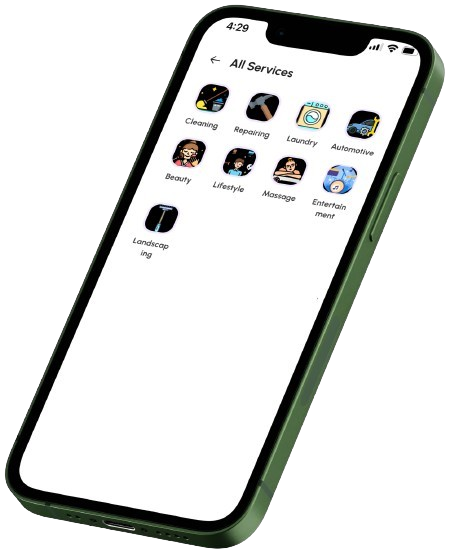The on-demand app industry has seen remarkable growth over the past decade, transforming the way consumers interact with services. From food delivery to home services, on-demand apps have become a key part of modern life, offering convenience, speed, and personalized experiences. The success of these apps is often attributed to their ability to meet consumer needs instantly, making them indispensable in today’s fast-paced world.
In this blog, we’ll explore the emerging trends in on-demand apps and what makes the best ones stand out. Specifically, we’ll look at how these trends are shaping apps like The Favor, a service app where users can find nearby services and service providers can offer assistance.
1. Hyperlocal Services and Location-Based Solutions
One of the most prominent trends in on-demand apps is the focus on hyperlocal services. Apps that provide location-based services have an edge because they offer users solutions that are immediate and relevant to their location. The Favor, for instance, thrives on this concept, allowing users to find nearby service providers for various needs, whether it’s home cleaning, car detailing, or even plumbing.
By leveraging GPS technology, on-demand apps can match users with service providers in their area, ensuring that users can get help quickly. This trend is not only about convenience but also about creating a personalized experience. The app’s ability to show real-time availability and track the service provider’s location during the service makes the process more transparent and reliable.
Why it works:
- Efficiency: Users can find nearby service providers without having to search through multiple platforms.
- Speed: Quick access to services is a priority for users who need urgent help.
- Transparency: Real-time tracking and location updates make the service more trustworthy.
2. AI and Machine Learning for Personalized Experiences
Artificial intelligence (AI) and machine learning (ML) are playing a huge role in the development of on-demand apps. These technologies help enhance the user experience by personalizing recommendations and automating processes.
For instance, The Favor app could use AI to recommend service providers based on the user’s past activities, preferences, and ratings. By analyzing user behavior, the app can learn what types of services the user needs most often and suggest the best service providers in their area.
Moreover, AI can optimize the matching process by predicting demand and automatically assigning orders to service providers who are best suited for the task. In the case of delivery services, AI can even predict traffic patterns and suggest the fastest routes for delivery.
Why it works:
- Personalization: Users receive tailored recommendations based on their preferences and previous interactions.
- Automation: AI helps automate repetitive tasks, making the app more efficient and responsive.
- Optimization: AI optimizes service delivery, ensuring users get the best experience possible.
3. Seamless Payment Solutions and Wallet Integration
On-demand apps are increasingly integrating seamless payment solutions, making transactions smoother for both users and service providers. With features like in-app wallets, users can pay for services instantly without having to leave the app. These payment solutions are also secure, ensuring that users feel confident when making payments.
For apps like The Favor, wallet integration is particularly useful for service providers who can manage their earnings directly within the app. It also simplifies the withdrawal process, allowing service providers to request payments at their convenience.
Additionally, incorporating multiple payment options such as credit/debit cards, mobile wallets, and even cryptocurrencies can attract a wider audience. Payment flexibility is a key feature that sets the best on-demand apps apart from the competition.
Why it works:
- Convenience: Users can pay instantly without needing to leave the app or enter payment details repeatedly.
- Security: Secure payment gateways build trust with users.
- Flexibility: Multiple payment options make it easier for users to pay in the way that suits them best.
4. Real-Time Tracking and Communication
Real-time tracking is one of the most significant trends in on-demand apps. Whether it’s tracking a food delivery, a home service provider, or a ride, users expect to see where their service is in real time. For The Favor app, real-time tracking allows users to monitor the service provider’s location and estimated arrival time, providing greater transparency and reducing anxiety.
In addition to tracking, effective communication is crucial. In-app messaging and notifications allow users and service providers to stay in touch, ensuring that the service is delivered as expected. Users can chat with service providers to clarify any details or update their preferences, while service providers can notify users of delays or changes.
Why it works:
- Transparency: Real-time updates build trust and keep users informed.
- Convenience: Instant communication makes it easier to address issues or make adjustments to the service.
- Customer satisfaction: Real-time tracking and communication help meet user expectations and improve the overall experience.
5. Subscription and Loyalty Programs
Subscription models and loyalty programs are becoming increasingly popular in on-demand apps. These models allow users to pay for a service on a recurring basis, often at a discounted rate. For example, The Favor could offer users a subscription plan that gives them access to discounted services, such as home cleaning or car detailing, on a monthly or yearly basis.
Loyalty programs, on the other hand, reward users for frequent use of the app. These programs can include points, discounts, or exclusive offers for users who continue to use the service. This approach not only boosts user retention but also encourages users to engage with the app more frequently.
Why it works:
- Customer retention: Subscription and loyalty programs encourage users to stick with the app long-term.
- Cost savings: Users benefit from discounted rates, which makes the service more affordable.
- Increased usage: Incentives encourage users to engage with the app more often.
6. Sustainability and Eco-Friendly Practices
As consumers become more environmentally conscious, on-demand apps are increasingly focusing on sustainability. This includes offering eco-friendly services, such as electric vehicle (EV) delivery options or using environmentally friendly products in home services.
For The Favor app, this could mean partnering with service providers who use sustainable practices or offering users the option to choose eco-friendly service providers. Not only does this appeal to environmentally conscious users, but it also helps businesses reduce their carbon footprint.
Why it works:
- Appeals to eco-conscious consumers: Many users prefer services that align with their environmental values.
- Differentiation: Sustainability can set an app apart in a competitive market.
- Corporate responsibility: Businesses can contribute to environmental conservation while appealing to a growing demographic.
7. Enhanced User Interface and Experience (UI/UX)
A seamless, intuitive user interface (UI) is crucial for the success of any on-demand app. The best on-demand apps focus on providing a smooth user experience (UX), with easy navigation, clear call-to-action buttons, and a visually appealing design.
For The Favor, the app’s UI should be simple and user-friendly, allowing users to quickly find and book services. The design should prioritize ease of use, with a clean layout and minimal distractions. Additionally, the app should be optimized for both mobile and tablet devices, ensuring that users can access services on any platform.
Why it works:
- User retention: A well-designed app is more likely to keep users engaged.
- Simplicity: A straightforward UI makes the app easier to navigate and use.
- Satisfaction: An intuitive design leads to a better overall user experience.
Conclusion
The on-demand app industry is evolving rapidly, with new trends shaping the way users interact with services. From hyperlocal solutions and AI-powered personalization to seamless payment systems and eco-friendly practices, the best on-demand apps are those that adapt to changing consumer expectations and technological advancements.
The Favor app is a perfect example of how these trends can be integrated into a user-friendly platform that meets the needs of both users and service providers. By focusing on location-based services, real-time tracking, personalized experiences, and sustainability, on-demand apps can create a seamless, efficient, and enjoyable experience for all. As the industry continues to grow, staying ahead of these emerging trends will be key to building the best on-demand app.





